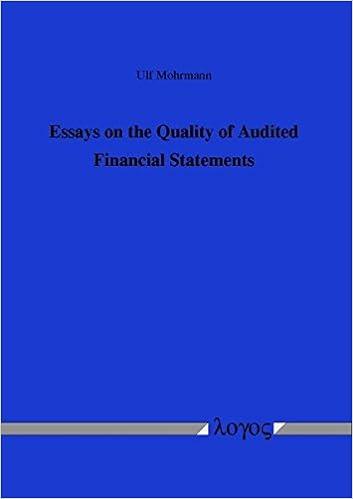Question
Hello, I have went through and answered these but wanted to have a more direct explanation. I used the FASB site for direction. I have
Hello,
I have went through and answered these but wanted to have a more direct explanation. I used the FASB site for direction. I have bolded the ones I chose.
Thank you,
Question 1:
A derivative designated as a hedge of a firm commitment (a documented forthcoming sale or purchase):
Select one:
A. Is marked to market each period, with the resulting gain or loss deferred in OCI until the sale or purchase takes place.
B. Offsets the hedged item that is marked to market each period, with the resulting gain or loss deferred in OCI until the derivative is closed out.
C. Remains off-balance-sheet until the sale or purchase takes place.
D. Is marked to market each period along with the hedged purchase or sale commitment, even though the sale or purchase has not occurred
Question 2:
If a derivative does not qualify for hedge accounting:
Select one:
A. Gains and losses are reported only when realized.
B. Changes in its fair value are reported in other comprehensive income.
C. Changes in its fair value are reported in income.
D. It is not reported on the balance sheet.
Question 3:
Which statement below accurately describes reporting for a cash flow hedge of an inventory purchase?
Select one:
A. Changes in the value of the hedge are reported in other comprehensive income until the inventory is purchased.
B. Changes in the value of the hedge are reported in other comprehensive income until the inventory is sold.
C. Changes in the value of the hedge are reported in income, along with changes in the forecasted purchase obligation.
D. Changes in the value of the hedge are reported in other comprehensive income, along with changes in the forecasted purchase obligation.
Question 4:
A company uses options to hedge its merchandise inventory. If the options qualify as a fair value hedge of the inventory, and analysis of hedge effectiveness excludes option time value, which statement is true concerning reporting for changes in the value of the options?
Select one:
A. Changes in intrinsic value adjust the carrying value of the merchandise when it is purchased.
B. Changes in intrinsic value adjust cost of goods sold when the merchandise is sold.
C. All changes in option value remain in other comprehensive income until the merchandise is purchased.
D. All changes in option value are adjustments to cost of goods sold as they occur.
Question 5:
Which of the following is a fair value hedge?
Select one:
A. A hedge of a forecasted sale transaction
B. A receive variable/pay fixed interest rate swap
C. A hedge of a forecasted purchase transaction
D. A receive fixed/pay variable interest rate swap
Question 6:
A company uses futures to hedge a firm commitment to buy inventory. Which statement is true concerning the hedge?
Select one:
A. The company takes a short position in futures and records changes in their value in OCI.
B. The company takes a long position in futures and records changes in their value in OCI.
C. The company takes a short position in futures and records changes in their value in income.
D. The company takes a long position in futures and records changes in their value in income.
Question 7:
When a share of a company's stock is selling for $55.00, a put option on the stock with a strike price of $56.00 is said to be:
Select one:
A. In the money
B. An American option
C. Carried at basis
D. Out of the money
Question 8:
When a share of a company's stock is selling for $55.00, a call option on the stock with a strike price of $56.00 is said to be:
Select one:
A. Out of the money
B. An American option
C. In the money
D. Carried at basis
Question 9:
A company uses options to hedge its forecasted purchase of merchandise. If the options qualify as a cash flow hedge of the forecasted purchase, and analysis of hedge effectiveness excludes option time value, which statement is true concerning reporting for changes in the value of the options?
Select one:
A. Changes in intrinsic value adjust cost of goods sold when the merchandise is sold.
B. All changes in option value remain in other comprehensive income until the merchandise is purchased.
C. All changes in option value are adjustments to cost of goods sold as they occur.
D. Changes in intrinsic value adjust the carrying value of the merchandise when it is purchased.
Question 10:
A company has a receive fixed/pay variable interest rate swap that qualifies as an effective hedge of its fixed rate debt. If interest rates rise:
Select one:
A. The loss on the debt and the gain on the swap are reported in income.
B. The swap is written off.
C. The gain on the debt and the loss on the swap are reported in income.
D. The change in the value of the swap is reported in other comprehensive income and adjusts future interest expense recognized on the debt.
Step by Step Solution
There are 3 Steps involved in it
Step: 1

Get Instant Access to Expert-Tailored Solutions
See step-by-step solutions with expert insights and AI powered tools for academic success
Step: 2

Step: 3

Ace Your Homework with AI
Get the answers you need in no time with our AI-driven, step-by-step assistance
Get Started


